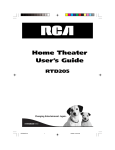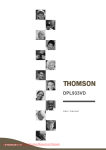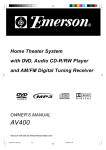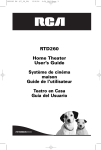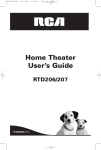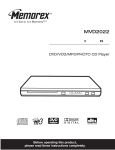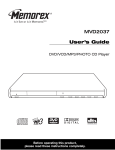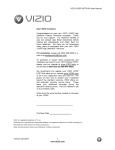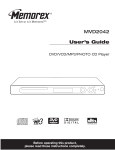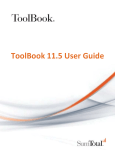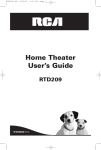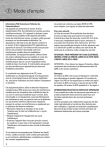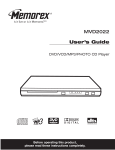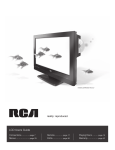Download RCA RTD170 System - C:\Users\JCBlackman\Desktop\For Xternal Hard Drive\RCA RTD170 Manual
Transcript
Table of Contents Connections and Setup Using the Radio Things to consider before you connect ................... 2 Accessories provided ................................................ 2 Front panel controls ................................................. 3 Front Panel Display ................................................... 3 Connecting to audiovisual equipment .................... 4 Connecting the antenna .......................................... 4 Magnetic shielding ......................................................... 5 Positioning speakers ....................................................... 5 Connecting the speakers ............................................... 5 Front Speaker Placement .............................................. 6 Preferred surround placement .................................... 6 Test Tone / Channel balance ........................................ 7 Manual tuning ........................................................ 19 Storing radio stations ............................................ 19 Retrieving preset stations ...................................... 19 Using the player menus .......................................... 20 Playmode Selection ................................................ 20 Standard ......................................................................... 20 Random (all discs except DVD) ......................................................... 20 Program (all discs except mp3/JPEG discs and JPEG) ................. 20 AutoDetect ..................................................................... 20 IntroScan (Audio CD only) .......................................... 21 Parental Control Settings ....................................... 21 Lock Player ...................................................................... 21 Change Password .......................................................... 21 Rated Titles ..................................................................... 21 Unrated Titles ................................................................. 21 Display Settings ...................................................... 22 TV Image ......................................................................... 22 Front Display ................................................................. 22 Black level ...................................................................... 22 Progressive Scan ........................................................... 22 Sound Settings ........................................................ 23 Night Mode .................................................................... 23 Distance .......................................................................... 23 Test tone ......................................................................... 23 Downmix ........................................................................ 23 Language settings ................................................... 24 Player Menus ................................................................. 24 Disc Menus .................................................................... 24 Audio ............................................................................... 24 Subtitles .......................................................................... 24 The remote control Remote Control functions in DVD/CD mode ........... 8 Remote control functions in Tuner mode ................ 9 Remote control functions in TV mode ...................... 9 Inserting batteries in the remote control ................ 9 Playing Discs – Basic Functions Compatible discs ..................................................... 10 Compatible formats ................................................ 10 Regional coding ...................................................... 10 Operating the DVD receiver ................................... 10 Description of the various menus ......................... 10 Basic Playback Operations ...................................... 11 Playback ........................................................................... 11 Accelerated play ............................................................ 11 Pause ................................................................................ 11 Frame advance ............................................................... 11 Variable slow motion ................................................... 11 Changing chapter/track .............................................. 11 Zoom ................................................................................. 11 Using Memory Cards Compatible Memory Cards ..................................... 12 Reading Memory Cards .......................................... 12 Using Auto-Detect ....................................................... 12 The Info Menu Using the Info Menu .............................................. 13 Time display ................................................................... 14 Title/Chapter (DVD)/Track (audio CD and VCD) ... 14 Subtitles (DVD) ............................................................. 14 Audio (DVD,VCD) .......................................................... 14 Play mode (all discs) .................................................... 15 Bookmark (DVD and audio CD) ................................ 15 Camera angle (DVD) .................................................... 16 PBC - PlayBack Control (VCD) .................................. 16 Sleep ................................................................................ 16 mp3 Files and JPEG Files Additional Information Troubleshooting ...................................................... 25 Precautions .............................................................. 26 Use ................................................................................... 26 Cleaning .......................................................................... 26 Handling and caring for discs .................................. 26 Disc Formats you can play ..................................... 27 DVD-Video ...................................................................... 27 DVD-R,DVD-RW, DVD+R, DVD+RW ........................ 27 VCD - Video Compact Disc ........................................ 27 SVCD - Super Video Compact Disc ......................... 27 Audio CDs ....................................................................... 27 CD-R, CD-RW ................................................................ 27 mp3 files ......................................................................... 27 JPEG files ........................................................................ 27 Kodak Picture CDs ........................................................ 27 Sound Enhancement Systems ................................ 28 Dolby Pro Logic II ......................................................... 28 Dolby Digital .................................................................. 28 Limited Warranty .......................................... 28 Playing mp3 files or displaying JPEG files .................. 17 Illustrations contained in this document are for representation only. RDT170 1 1/31/05, 7:46 AM 1 Connections and Setup Things to consider before you connect • Ensure that the mains supply in your house complies with that indicated on the identification sticker located on the back of your unit. • Install your unit horizontally, away from any source of heat (fireplace) or appliances creating strong magnetic or electric fields. The components of this unit are sensitive to heat. The maximum ambient temperature should not exceed 35° Celsius. • Leave enough space around the unit to allow adequate ventilation: 10 cm on either side and above the top, and 5 cm at the rear. • The humidity of the room should not exceed 75%. If you have to use the unit outdoors, do not expose it to rain or splashing water. The apparatus should not be exposed to dripping or splashing and no objects filled with liquids, such as vases, should be placed on the apparatus. • Moving the unit from a cold place to a warm one can cause condensation on some components inside the unit. Let the condensation disappear on its own before turning the unit on again. • Before moving the player, make sure the disc tray is empty. Other important use and cleaning information at the end of the booklet. Accessories provided Remote control and 2 non-rechargeable AAA batteries + - - + Left and right front speakers Center speaker 1 x Pig-tail antenna wire 6 x Stripped wires for speakers Subwoofer Left and right rear speakers Caution! Invisible laser radiation when open. Avoid exposure to beam. Class 1 laser product. This system must be opened only by qualified technicians to prevent accidents caused by the laser beam. DVD copy protection In accordance with the DVD standard, your DVD player is equipped with a Copy Protection system, which can be switched on and off by the DVD disc itself, in order to make any recording of the relevant DVD disc onto a videotape of very poor picture quality, or even impossible. This product incorporates copyright protection technology that is protected by method claims of certain U.S. patents and other intellectual property rights owned by Macrovision Corporation and other rights owners. Use of this copyright protection technology must be authorized by Macrovision Corporation, and is intended for home use only unless otherwise authorized by Macrovision Corporation. Reverse engineering or disassembly is prohibited. 2 RDT170 Illustrations contained in this document are for representation only. 2 1/31/05, 7:46 AM Connections and Setup Front panel controls DVD Home Theatre System RTD170 VOLUME + SOURCE ON/STANDBY SUBWOOFER SD/MMC/SMC/MS CARD COMPACT FLASH CARD ON/STANDBY - Switch the unit on and off. playback. Move to the next preset memory location in tuner mode. Open and close the disc tray. Start playing a disc. Pause. Stop disc playback. Skip to the previous chapter or track during playback. Go to the previous preset memory location in tuner mode. SOURCE - Select the input source. SUBWOOFER - Toggle between different subwoofer modes. VOLUME +/- - Adjust the sound volume. Skip to the next chapter or track during Front Panel Display Speaker icons PLII Audio output in Dolby PL II Movie, Dolby PL II Music or Dolby Prologic Emulation mode. DVD/CD/VCD/WMA/MP3 Type of disc loaded. Disc in playback or in pause. SLP Sleep mode activated. STEREO Tuner stereo signal detected. TITLE Title number (DVD). REP 1 / REP / A-B Playback in repeat mode. P-SCAN Progressive Scan activated. TRK Track number. kHz / MHz Tuner frequency unit. DIGITAL Audio output in Dolby Digital mode. CHP Chapter number (DVD). TUNED Radio station tuned. Note: Dolby and the double-D symbol license from Dolby Laboratories. PRESET Preset station number. PROG Program mode activated. are trademarks of Dolby Laboratories. Manufactured under 3 RDT170 3 1/31/05, 7:46 AM Connections and Setup Connecting to audiovisual equipment AUDIO OUT (VCR) COMPONENT VIDEO (TV) AUDIO OUT (SAT) Pr Pb Y COMPONENT VIDEO 1 VIDEO OUT Note: Use only one of the connection methods shown above for each device. AUDIO IN L (left) and AUDIO IN R (right) jacks (AUX 1 and AUX 2) These are analog audio output jacks. The AUDIO L jack and cable are white, while the AUDIO R jack and cable are red. Audio cables (red and white) Component video out Component cable The Y, Pb, Pr jacks provide optimum picture quality by separating the video signal into three parts. To ensure maximum picture quality, use three videograde cables (yellow) for the connection. You can also buy bundled component video cables that are color-coded to match the Y, Pb, Pr inputs (green, blue and red). Note: If your television is a high definition television, use the DVD player’s progressive scan output to get the highest possible video resolution. Set the Progressive Scan option in the Display menu to On (see page 22). Note: If one of the devices is not working, check that all the cables have been inserted properly into the jacks. Connecting the antenna The FM antenna (provided) should be connected to the FM aerial jack at the back of the unit. Note: For FM reception, extend the antenna to its full length. 4 RDT170 4 1/31/05, 7:46 AM Connections and Setup Connecting the speakers Six speakers are provided with the unit (2 front, 1 center, 2 rear, 1 subwoofer). To achieve good surround effects, all six speakers need to be connected to the receiver. One speaker wire is provided for each speaker connection. Speaker wires are color-coded to match the terminals. SUB CEN SR SL FR Connect the speaker wire to the back of each speaker and to the corresponding color terminal at the back of the unit. Press down the tab to open the terminal and insert the wire (1). Release the tab to lock wire in the terminal (2). Do the same for center speaker, rear speakers and the subwoofer. FL SPEAKERS 8 Ω 4Ω Note: When connecting the speakers, make sure the polarities (“+” speaker wire to “+” on the receiver) of speaker wires and terminals match. If the cords are reversed, the sound will be distorted. Do not ground the output line, it will damage the speaker. (1) R l 3 b l k i (2) i h Positioning speakers 1 1 Left, Right (Front Speakers) Front speakers carry primarily music and sound effects. 2 1 3 2 Center In surround mode, the center speaker carries most of the dialog as well as music and effects. It should be set between the left and right speakers. 3 Surround (Rear Speakers) Courtesy Dolby Laboratories The rear speakers’ overall sound balance should be as close as possible to the front speakers. Proper placement is vital to establish an evenly distributed sound field. Subwoofer A subwoofer is designed to reproduce powerful low bass effects (explosions, the rumble of spaceships, etc.) which dramatically heighten the action on the screen. Magnetic shielding Speakers placed less than two feet from the TV set must be magnetically shielded in order to prevent picture distortion. Front and center speakers provided with this unit are magnetically shielded to protect your TV set. Note: It is not recommended to place the rear speakers and subwoofer near the TV set. 5 RDT170 5 1/31/05, 7:46 AM Connections and Setup Front Speaker Placement Follow the suggestions for speaker placement below to get the best results. Alignment Courtesy Dolby Laboratories Align the center speaker evenly with (A) or slightly behind (B) (the left and right speakers), but not ahead of them. Angle Place the left and right speakers to form a 45-degree angle with your favorite viewing position to duplicate the soundtrack mixer’s perspective. Height Courtesy Dolby Laboratories The mid- and high-frequency drivers of the three front speakers should be as close as possible to the same height. This often requires placing the center speaker directly on top (A) or beneath (B) the TV set. Preferred surround placement Location If possible, place surround speakers to either side of the listening area, not behind it. Height If space permits, install surround speakers 2-3 feet above viewers. This helps to minimize localization effects. Aiming Aim surround speakers straight across the room, not down at viewers, to help create a more open, spacious surround sound field. Alternative Surround Placement Rear wall If rear wall mounting is the only choice, aim the speakers at each other (A), towards the front (B) or towards the sidewalls (C, D). Experiment with placement until sounds seem to surround you, rather than come from behind you. 6 RDT170 6 1/31/05, 7:46 AM Connections and Setup No adjacent walls Surround speakers can go on stands facing each other to approximate sidewall mounting (A), or to the sides or rear of the viewing area, aimed upwards; they can go right on the floor, or preferably, a few feet off the floor such as on end tables (B). Test Tone / Channel balance Channel balance Your receiver is equipped with a test signal generator for balancing the channels. As the signal “travels” from channel to channel, adjust the level controls until each channel plays at the same loudness level (see page 22). Level adjustment and surround channel level expectation Even though you adjust the surround channel to be as loud as the others on the test signal, on actual program material the surround channel is usually much lower than the front. Don’t re-adjust the surround level; program producers use surround for subtle atmospherics and ambience, and only rarely for special effects. 7 RDT170 7 1/31/05, 7:46 AM The Remote Control The remote control Navigating through menus Use the direction buttons to navigate through the menus. Press the OK button on the remote control to confirm your selection. Remote Control functions in DVD/CD mode ON OFF DVD•CD TUNER TV GO BACK CH VOL MUTE RETURN CLEAR SAVE MENU TUNER – OK TUNER + SUBWOOFER SURROUND TITLE•GUIDE EQ. LEVEL INFO DISC 1 2 3 4 5 6 ANGLE 7 8 NIGHT DVD 9 INPUT 0/-- AUDIO REVERSE PLAY FORWARD ZOOM STOP PAUSE AUX 2 VCR AUX 1 SAT•CABLE RECORD PLAY MODE CLOCK•WAKE Switches the unit on and off. DVD•CD Selects the DVD player. +/- Adjusts the sound volume. (mute) Mutes and restores the sound. RETURN Returns to the previous menu. Directly accesses the next or previous chapter (DVD) or track (CD). CLEAR Hides the Info menu. If you are in the menu system, returns to main menu. MENU Accesses the disc menu during play (if available). SURROUND Changes the Surround sound setting. EQ. LEVEL Toggles between equalizer, BASS/TRE and channel settings. INFO Accesses the Info menu. TITLE•GUIDE Accesses the disc menu. SUBWOOFER Selects among subwoofer output levels. 0-9 Number entry. ANGLE Accesses the camera angle function. NIGHT DVD Activates Night Mode (see page 22). AUDIO Accesses the audio function of the Info menu. REV Starts reverse accelerated play or reverse slow motion. PLAY Starts playing a disc. FWD Starts forward accelerated play or forward slow motion. STOP Stops play and accesses the main menu. PAUSE Freeze frame, frame advance or slow motion. ZOOM Accesses the Zoom function. PLAY MODE Accesses the play mode function of the Info menu. AUX1 / AUX2 Selects various audio/video sources. Note: In AUX1, AUX2 and TV modes, you need to press the button twice within 2 seconds to turn off the component. 8 RDT170 Illustrations contained in this document are for representation only. 8 1/31/05, 7:46 AM The Remote Control Remote control functions in Tuner mode TUNER Selects the tuner. +/- Adjusts the sound volume. (mute) Mutes and restores the sound. Selects programmed stations. MENU Stores a station. TUNER- / TUNER+ Tunes down and up the radio frequencies. AUDIO Toggles between Stereo and Mono modes. Remote control functions in TV mode Note: The buttons described below operate as specified, provided that the function is available on the television. TV PR+/- Selects the TV. Changes the channel. GO BACK Returns to the previous channel. CLEAR Exits a menu. MENU Accesses the TV’s main menu. ZOOM Accesses the Zoom function (16x9 TV only). INFO Provides information about the channel. TITLE•GUIDE Displays the program guide. 0-9 Selects a channel. For 2-digit channels, first press 0. Inserting batteries in the remote control • Do not mix different types of batteries or new and old batteries. Do not use rechargeable batteries. • In order to avoid any risk of explosion, observe the polarities indicated inside the battery compartment. Replace only with the type of batteries specified. Do not dispose of them in a fire or recharge them. • If you are not using the remote control for a long period of time, remove the batteries. Please respect the environment and prevailing regulations. Before you dispose of batteries or accumulators, ask your dealer whether they are subject to special recycling and if they will accept them for disposal. N 9 RDT170 9 1/31/05, 7:46 AM Playing Discs – Basic Functions Compatible discs • DVD • DVD-R,DVD-RW, DVD+R, DVD+RW • CD • CD-R, CD-RW. Compatible formats • DVD, VCD (Video Compact Disc), SVCD (Super Video Compact Disc), JPEG • CD, mp3, CD Kodak Picture. See page 26 for more information about discs and compatible formats. Regional coding Your DVD player has been designed to process regional management information stored on DVD discs. The regional code for your player is 1. Discs that have a different regional code will not play. Operating the DVD receiver 1. Turn on your television set. 2. Press the DVD•CD button on the remote control. Press the STANDBY button located on the DVD player’s front panel. button on the remote or ON/ Description of the various menus • Disc menu – The appearance and contents of this menu varies according to the type of disc you have inserted. It is separate from the player menu. When the disc is playing, press the TITLE•GUIDE button to toggle the menu on or off. 00:02:16 T : 01 C : 02 1 of 1 Z Z Z . . . • Info menu – The player’s Info menu appears as a bar at the top of the screen while the disc is playing. Press the INFO button on the remote to toggle the Info menu on or off. • Player menu – If no disc has been inserted, the player menu appears automatically. If a disc is being played, press the STOP button to access this menu. PLAY Play Play Mode Standard Parental Control Random Display Program Sound Auto-Detect Languages IntroScan Note: A function is only available if it is on the disc you have inserted. For instance, if you select the Subtitles function from the Info menu, subtitles will only appear if subtitles have been provided on the disc. If a menu or icon appears grayed out, the menu or the associated function is not available. P 10 RDT170 Illustrations contained in this document are for representation only. 10 1/31/05, 7:46 AM Playing Discs – Basic Functions Basic Playback Operations Playback Switch the DVD player and the TV set on. 1. Press the button on the front of the player to open the disc tray. 2. Put the disc in with the printed side up (in the case of a single-sided disc). 3. Press again to close the disc tray. Play starts automatically, or the disc menu appears. If the disc menu appears, select the Play option to begin playback. 4. Press STOP to stop playback. Note: When you press STOP, the player stores the point where playback was interrupted. If you press PLAY again, playback resumes from this point. To stop playback completely or to start again from the beginning, press STOP twice. If the player is left in STOP mode for more than two minutes without any user interaction, a screen saver is activated. At the end of 30 minutes without any user interaction, the player switches off automatically. Accelerated play While the disc is playing, press the REV or FWD button one or more times to vary the speed and direction of the accelerated play. Press PLAY to resume normal playback. Pause While the disc is playing, press PAUSE once for freeze frame. Press PLAY to resume normal playback. Frame advance 1. Press PAUSE twice. FRAME is displayed. 2. Press the REV or FWD button to advance backward or forward image by image. 3. Press PLAY to resume normal playback. Variable slow motion 1. While the disc is playing, press the PAUSE button once. PAUSE is displayed. 2. Press the REV or FWD button to vary the speed and direction of the slow motion. 3. Press PLAY to resume normal playback. Note: Backward slow motion is not available on VCDs. Changing chapter/track While the disc is playing, press the left/right arrow button to go immediately to the next or previous chapter, or to the next or previous track. Zoom 1. While a disc is playing, press the ZOOM button until you reach the zoom size you want. 2. Move from one area to another (pan) using the arrow buttons. 11 RDT170 11 1/31/05, 7:46 AM Using Memory Cards Your receiver has two memory card slots. You can transfer information (jpeg or mp3 files) from your memory cards to the receiver and display the pictures on screen or play the mp3 files. The upper slot can read different formats; the lower slot is for Compact Flash Cards. Compatible Memory Cards • Compact Flash 1 and 2 • MultiMedia Card • Secure Digital • Memory Stick • Smart Media Reading Memory Cards The Auto-Detect Feature The Receiver has an Auto-detect feature that reads the type of card you’ve inserted and displays a dialog box asking if you want to access the card. By default, auto-detect is turned on. You can turn this feature off so no message appears (see page 20). When Auto-detect is on, and a disc is playing, the receiver will pause playback and ask if you want to continue playback, or access the card. It will also show you what type of card is in the slot when you turn it on. If auto-detect is off, no message appears when you insert a card. You must press the INPUT button on the remote to access the card. If a card was left in the slot when you last turned the unit off, no message will appear unless you press INPUT. 1. With no disc playing, insert your memory card into the slot. Card inserted. To continueplaying disc, pres PLAY/PAUSE or remove card. To stop playing disc and access card, press STOP. Note: If you insert a card while a disc is playing, a dialog box is displayed, giving you the option of continuing to play the disc or to stop disc playback and access the memory card. AUTO-DETECTION ON. If you don’t want this message to appear again, turn off auto-detect in the Play Mode menu (press MENU). 2. A dialog box is displayed showing a list of the types of media that are in the receiver (DVD, Memory Card). 3. Use the up/down arrow buttons to select the Memory Card option. If there is more than one memory card inserted, a submenu will appear. Use the up/down arrow buttons to select the card you want to access. 4. Press OK to select. The contents of the card is displayed. Note: Although your memory card may be compatible with the unit, the data on the card must be in a format the rceiver can read (jpeg or mp3). 12 RDT170 Illustrations contained in this document are for representation only. 12 1/31/05, 7:46 AM The Info Menu Using the Info Menu Press the INFO button on the remote while a disc is playing to display the Info menu. Use the right/left arrow buttons on the remote to select an icon. Use the up/down buttons to scroll through the options. When the option you want is highlighted, press OK to select it. To directly access a title or a chapter (DVD), a track (audio CD and VCD), select the icon and enter a number using the numeric buttons on the remote. Notes: Many discs only have one title. When one of the icons is grayed out, this means that the function is not available on the disc. The invalid symbol indicates that the function selected or the button used is not available. Illustrations contained in this document are for representation only. RDT170 13 1/31/05, 7:46 AM 13 The Info Menu 01:49:37 Time Display To access the Time Display, press the INFO button on the remote. Use the left/ right arrow buttons to select the Time display icon. Press the up/down buttons repeatedly to display: DVD: Chapter elapsed time, Chapter remaining time, Title elapsed time and Title remaining time. VCD and audio CD: Track elapsed time and Track remaining time. To directly access a location on the disc which does not correspond to the start of a title or chapter, enter a time with the number buttons (hh:mm:ss). Note: This function may not be available on all discs. Title/Chapter (DVD) / Track (audio CD and VCD) T:1 C: 12 To directly access a title, chapter (DVD) or a track (audio CD and VCD), press the INFO button, then select the Title or Track icon with the left/right arrow buttons. Choose a number using the up/down buttons or enter a number directly with the numeric buttons. Note: Many discs only have one title. Subtitles (DVD) Subtitles are turned off by default. Turn on Subtitles as follows: 1. While the disc is playing, press the INFO button, then select the Subtitles icon using the left/right arrow buttons. 2. Select a language using the up/down arrow buttons. 3. To turn subtitles off, select the Off option. Notes: When you change the language of the subtitles using the Info menu, it only applies to the disc currently being played. When you eject the disc and switch off the player, the subtitles will default to the subtitle language you selected in the Languages menu (see page 23). This function may not be available on all discs. Audio (DVD,VCD) Some discs have several audio tracks used for different languages or different audio formats. To change the language or audio format during playback: 1. Press the INFO button. 2. Use the left/right arrow buttons to select the Audio icon, or press the AUDIO button on the remote control. 3. Choose a language or an audio format with the up/down arrow buttons. Notes: This option is only available if the disc offers dialog languages or audio formats. When you change the dialog language using the Info menu, it only changes the dialog language of the disc being played. When you eject the disc or switch off the player, the language will revert to the one you selected in the Languages menu (see page 23). 14 RDT170 14 1/31/05, 7:46 AM The Info Menu Play mode (all discs) Note: For mp3 play modes, please refer to page 16. 1. While the disc is playing, press the INFO button. 2. Select the Play mode icon using the left/right arrow buttons, or press the PLAY MODE button on the remote control. 3. Use the up/down arrow buttons to select an option. • DVD play modes: standard, program, title repeat, chapter repeat, A-B repeat. Notes: Program play mode is only available if a programmed list has been created (page 19). Repeat mode is only available with discs that display elapsed time and remaining time. To repeat a sequence between points A and B, choose the A-B repeat option, and then follow the instructions for entering the two points. If, during a fast forward or reverse, point B is reached, the player continues playback at normal speed from point A. If, during a fast search, point A is reached, the player starts playback from point A at normal speed. • VCD and SVCD play modes: standard, disc repeat, track repeat, A-B repeat. PBC must be turned on for Repeat functions to work. • Audio CD play modes: standard, program, random, disc repeat, track repeat, A-B repeat, IntroScan. Note: IntroScan plays the first ten seconds of each track. When all the tracks have been scanned, IntroScan stops. If you want to continue playing the track being scanned, press the PLAY button. Press the STOP button to stop IntroScan. 3. To stop repeat playback, select the Play mode icon and choose the Standard option, or press the STOP button twice. Bookmark (DVD and audio CD) The player can store up to 12 disc locations as long as the disc remains in the player and the unit remains switched on. Note: This function is only available with discs whose elapsed time or remaining time appears in the Info menu. 1. Press the INFO button. Select the Bookmark icon with the left/right buttons, and press OK. A menu is displayed with six bookmarks. To display the other six bookmarks, press the down arrow button. 00:06:18 T1 00:28:04 T01 03:24:09 T01 Unmarked 4 02:12:56 T02 Unmarked 6 Play button “unmarked” icon 2. To create a bookmark, select a position shown as “unmarked” using the arrow buttons and press OK. 3. To start playback from a bookmark, select Play icon and press OK. 4. To delete a bookmark, select the trashcan icon and press OK. 15 RDT170 15 1/31/05, 7:46 AM The Info Menu Camera Angle (DVD) 1 of 3 Some discs offer different camera angles for specific scenes. 1. To change the camera angle, press the ANGLE button on the remote or press the INFO button and select the Camera angle icon with the left/right buttons. 2. Choose the angle with the up/down arrow buttons. Note: If the disc was recorded using a single camera angle, this function is not available. PBC - PlayBack Control (VCD) PBC The PlayBack Control function offers scenes and information which can be selected through a menu. It can also be used to display high-resolution pictures, if the disc contains any. Press the INFO button, then select the PBC icon. Press the up/down buttons to enable or disable this function. Z Z Z . . . Sleep 1. Press the INFO button, then select the Sleep icon with the left/right arrow buttons. 2. Select one of the available options using the up/down arrow buttons: Off, 30, 60, 90 or 120 minutes. 16 RDT170 16 1/31/05, 7:46 AM mp3 Files and JPEG Files Playing mp3 Files or Displaying JPEG Files mp3 is an audio file format which compresses recorded music. The main advantage of the mp3 format is that CD-quality music tracks can be stored on a personal computer in user-friendly compressed files. JPEG files are image files. Make sure that they have a resolution of less than 2 megapixels. Note: The time taken for the contents of the disc to be displayed varies according to the size and number of JPEG files on the disc. If nothing is displayed after a few minutes, the file sizes may be too large. Reduce the files’ resolution and write another disc. Before inserting a disc or memory card, make sure it is compatible with the player. . 1. Open the disc tray. 2. Place the disc with the printed side facing up. 3. Select a folder using the up/down arrow buttons on the remote, then press OK to display the list of files or press PLAY to start playing all the files contained in the folder. 4. Select a file using the arrow buttons. Press OK and then PLAY to start playback. PLAY 2000 Curr ent Selection I will sur vive Robbie Williams RobbieWilliams mp3 Torn Angel Beautiful Testify Not selected • mp3 file: the player begins playing the selected file, then all the files and subfolders contained in the same folder. The player then plays the contents of the folders at the same level as the folder containing the file selected at the start. Note: While listening, you can use the button to go back to the previous track or the button to go on to the next one. PLAY 2000 • JPEG file: the player starts the slide show with the JPEG file you have selected, then displays all the JPEG files in the same folder, then all the JPEG files in the subfolders located in the same folder. Curr ent Selection EiffelTower Tr ocadero Not selected Louvre1 Louvre2 Note: During the slide show you can use the ANGLE button to rotate the picture 90°, the ZOOM button to magnify the picture, the button to go back to the previous picture or the button to go to the next one, and the STOP button to interrupt the slide show and display the disc’s contents. Concor de /2000/ Mum and dad 5. Press the INFO button to display the Info menu during playback. Z Z Z 00:02:45 PLAY . MP3 Angels . . None mp3 file: press the up/down arrow button to select a playback mode (Standard, Random, Track repeat, Folder repeat, Disc repeat), and press OK. mp3 Play Mode : Standard Z Z Z JPEG PLAY None . . . Holidays 03 JPEG file: press the up/down arrow button to select a projection speed. Slideshow speed:Fast 6. When the player has played all the files, the music or slide show stops and the disc’s contents are displayed again. 7. Press STOP to end playback. Illustrations contained in this document are for representation only. RDT170 17 1/31/05, 7:46 AM 17 mp3 Files and JPEG Files Playing JPEG and mp3 Music Files at the Same Time You can display JPEG files while listening to mp3 music files recorded on the same disc. 1. Insert the disc containing the two types of files in the player. PLAY 2000 Curr ent Selection I will sur vive Robbie Williams RobbieWilliams mp3 Torn Angel 2. Select an image file using the arrow buttons, then press OK. The name of the folder where the file is located and the name of the file appear on the right in the “Current selection” section. 3. Select an mp3 music file using the arrow buttons, then press OK. The name of the folder where the file is located and the name of the file appear on the right in the “Current selection” section. Killian Testify 2000 Mum and dad Note: To delete your selection, press the CLEAR button. 4. Press INFO to access the Info menu during playback. You can change the slide show’s projection speed using the up or down arrow button. Z Z Z 00:02:45 PLAY MP3 Angels JPEG . . . Holidays 03 5. During playback you can use the button to go back to the previous picture or the button to go to the next one. Slideshow speed:Fast 18 RDT170 18 1/31/05, 7:46 AM Using the Radio The unit has a built-in tuner for FM radio function. Manual Tuning 1. Connect the FM antenna. 2. Press the TUNER button on the remote. 3. When the FM station broadcasts Stereo sound, STEREO is displayed. 4. Tune a station by pressing TUNER + or TUNER - on the remote until the desired station is found. You can also press and hold the TUNER +/- button for approximately one second to use the automatic search function; in this mode, the unit will automatically find a station. 5. Repeat step 4 to tune to another radio station. Note: If there is interference, change the location of the antenna until you get optimal sound. TV and other electronic devices could cause interference. Position the antenna away from electronic devices. Automatic preset programming 1. Press the TUNER button on the remote control to select TUNER mode. 2. Press and hold TUNER for 3 seconds to start the automatic preset programming. Note: A weak signal can affect the “Automatic preset programming function.” You may need to adjust the antenna for a more efficient search. 3. Radio frequencies will be browsed and radio stations stored automatically. When all the available radio stations are stored, or if all 40 memory locations are full, the auto preset programming will stop. Manual preset 1. Tune to a radio station (see Manual tuning on the left). 2. Press MENU on the remote control. PRESET will appear on the display. 3. While the display is flashing P01,2, input your desired preset number (1-40) using the up/down arrow buttons. Press Menu to store it. Storing Radio Stations Retrieving Preset Stations The receiver can store up to 40 radio stations. You can enter radio stations yourself, or the receiver can store all available radio stations automatically, in ascending order. 1. Press the TUNER button on the remote to enter the tuner mode. 2. Press or on the unit or PR+ or PRon the remote to search up or down the preset stations. Illustrations contained in this document are for representation only. RDT170 19 1/31/05, 7:46 AM 19 Player Menus Using the Player Menus The player’s main menu is displayed when there is no disc in the player or when playback has been stopped by pressing the STOP button. Select a menu option using the arrow buttons. Press OK to select. Return to a previous menu using the left arrow button. Play Mode Selection Play Play Mode Standard Parental Control Random 1. Load a disc and press STOP. Display Program 2. Select the Play Mode option and press OK. Sound Auto-Detect Languages IntroScan Note: The content of the Play Mode menu varies depending on the type of disc. 3. Select a play mode with the up/down arrow buttons, and press OK to select. Standard Press OK or the PLAY button to begin the disc’s standard playback. Random (all discs except DVD) You can listen to all the tracks on the disc in random order by choosing the Random option. Press OK to start random playback. Press STOP to stop random playback. Press PLAY to resume normal playback. Program (all discs except mp3/JPEG discs and JPEG) With this option, you can program the playback order. Lists vary according to the type of disc. 1a. DVD: Select a title using the up/down arrow buttons and press the right arrow button to access the list of chapters. Select a chapter using the up/down arrow buttons. 1b. Audio CD and VCD: Select a track using the up/down arrow buttons, or select All to start playing all the tracks. 1c. mp3: select a folder using the up/down arrow buttons, then press the right arrow button to access the list of files. Select a file using the up/down arrow buttons. 2. Press OK to add the title, chapter (DVD), track (audio CD and VCD) or file (mp3) to the list. 3. Press the CLEAR button to remove the last title/chapter/track/file from the list. 4. Press PLAY to start program play or select Done and press OK. Repeat steps 1 and 2 as necessary. Auto-Detect When Auto-Detect is turned on, it reads what type of memory card has been inserted into the card reader and displays a dialog box with options (see page 12). When Auto-detect is turned off, no message is displayed; the card is accessed by pressing the INPUT button on the remote. Auto-detect has two submenus: one for what action you want the unit to take when a disc is playing, and one for listing the types of media currently in the player (disc, memory card) and the option to select which type of media you want to access. Use the arrow buttons to highlight your choice (On or Off) and press OK to select. 20 RDT170 Illustrations contained in this document are for representation only. 20 1/31/05, 7:46 AM Player Menus IntroScan (Audio CD only) This option plays the first ten seconds of each track. Press OK to start IntroScan, press STOP to stop it and PLAY to continue playing the current track. Parental Control Settings You can control access to the player and the type of discs your family can watch with the lock function. There are eight levels of parental control. Select the Parental Control option in the main menu and press OK. The Parental Control menu is displayed. Play Mode Lock Player Play Play Mode Parental Control Lock Player Display Change Password Sound Rated Titles Languages Unrated Titles Free Access This setting prevents playback of DVDs that may not be suitable for all audiences by using the rating level encoded on the disc (not all discs are rated). If the rating level of the disc is higher than the preset level, playback is prohibited unless a password is entered. 1. To activate locking according to your preset rating limits, select the Lock Player option using the up/ down arrow buttons and press OK. 2. You are asked for a new password. Enter four digits using the number buttons and press OK. You are asked for confirmation; enter the four digits again and press OK. Note: Choose a password that is easy to remember, or write it down. 3. To unlock, select the Parental Control option. Enter your password. Select the Lock Player function and press OK. Change Password 1. To change the password, select the Change Password option and press OK. 2. Enter the four digits of your new password. Rated Titles The disc publisher is responsible for coding scenes according to the rating limits. 1. Select Rated Titles and press OK. 2. For the rating limit, select the level using the up/down arrow buttons and press OK. Unrated Titles 1. To set up password-only access to unrated titles, select Unrated titles and press OK. 2. Select Password required using the up/down arrow buttons and press OK. Note: You must put the player into Lock mode (see above) for the Rating Limits to apply. 21 RDT170 21 1/31/05, 7:46 AM Player Menus Display settings Play Play Mode Parental Control TV Image 4x3 standard Display Front display Dim Sound Black level Normal Languages PAL/NTS C PAL 1. Select the Display option in the main menu using the up/down arrow buttons and press OK. 2. Select an option using the left/right arrow buttons and press OK. 4x3 TV Image Depending on the format of the DVD disc, you can choose the picture format (aspect ratio) best suited to the format of your TV screen: 4x3 Letterbox: gives best reproduction of pictures recorded in this format (i.e. with horizontal bands at the top and bottom of the screen) or in 16x9. 4x3 Standard: reproduces a 4x3 picture without distortion. 16x9 Widescreen: reproduces 16x9 format films in full on a 16x9 screen. Front Display This option lets you choose how the front display of the DVD player appears. Four settings are available: Auto: the front display dims when a disc is playing. Bright: the front display is always bright. Dim: the front display is always dim. Black level This option lets you adjust the video brightness level. Three settings are available: Normal, Dark and Light. Progressive Scan Progressive Scan provides high quality pictures with less flickering. Turn on Progressive Scan if you used the Component Video jacks of the player to connect a TV or monitor compatible with a progressive scan signal. Press OK to activate Progressive Scan. IMPORTANT! Once Progressive Scan has been activated, an image will only be visible on a progressive scan TV or monitor. If you activate Progressive Scan by mistake, follow the procedure below to reset the unit: Press and hold the SUBWOOFER button on the remote control. The video output will be restored to the standard setting and a picture will once again be visible on a conventional analog TV or monitor. 22 RDT170 22 1/31/05, 7:46 AM Player Menus Sound settings Play Play Mode Night Mode Parental Control Distance Display Test Tone Sound Downmix You can adapt your player to other equipment and access specific functions with the Sound menu. 1. Select the Sound option in the main menu using the up/down arrow buttons and press OK. Languages 2. Select an option using the left/right arrow buttons, and press OK. Play Night Mode You can use this function to control the different sound levels via dynamic compression. It improves the quality of the sound track at a low volume and quiets the loudest sounds. Select an option using the up/down arrow buttons: Quiet, Moderate or Off. Note: This function is available only on DVD discs recorded in Dolby Digital. Distance Basic settings have been preset for the speakers included with your unit. However, to suit the acoustic conditions in your listening room and to make the sound more effective, you may need to delay the signal coming from some of the speakers. Channel delay compensates for center or surround speakers that are closer to the listening position than the front speakers. 1. Select Front, Center or Rear using the and buttons and press OK. 2. Adjust the distance using the and buttons and press OK. Note: The receiver speaker distance default settings are the following: Front speakers (L/R): 4.5 m Center speaker (Cch): 3 m Rear speaker (SUR): 3 m Test tone This function is used to test the speaker setting and change the speaker level. A short noise comes successively from each speaker. Adjust the volume level using the up/down arrow buttons. Downmix This function can process a multi-channel audio source to a two-channel stereo signal. The options are: Stereo and Off. 23 RDT170 23 1/31/05, 7:46 AM Player Menus Language settings Play Play Mode Parental Control Player Menus English Display Disc Menus English Sound Audio English Languages Subtitles English With this menu, you can set the language for player menus, dialog, subtitles and the disc menus. If you chose “English” during initial set-up, any menus generated by the disc are in English, and so is the language of the dialogs (if this language is available on the disc). 1. Select the Languages option in the main menu using the up/down arrow buttons and press OK. 2. Select one of the options using the up/down arrow buttons and press OK. English Eitles Audio Player Menus To change the language of the player menus, choose the language using the up/down arrow buttons and press OK. Disc Menus To change the language of the disc menus, choose the language using the up/down arrow buttons and press OK. Audio 1. To change the dialog language, choose the language using the up/down arrow buttons and press OK. Note: If the selected language is not available on a disc, the disc’s language will be used instead. 2. To change the language during play, display the audio icon by pressing the AUDIO button on the remote (see page 13). Subtitles 1. To change the subtitle language, choose the language using the up/down arrow buttons and press OK. Note: If the language chosen is available, it is automatically selected when you display the subtitles (see page 13). Otherwise, the subtitle language indicated on the disc is selected . 2. To change the language of the subtitles during playback, display the Info menu by pressing the INFO button on the remote (see page 13). 24 RDT170 24 1/31/05, 7:46 AM Additional Information Troubleshooting The unit does not switch on. • Make sure it is plugged in. • Press the button on the remote control or the ON/STANDBY button on the front of the unit. The device switches off spontaneously. • The device switches off automatically when it is in STOP mode for more than 30 minutes without any user intervention. Switch it on again. It is impossible to read the disc. • Insert the disc with the printed side facing up. • Check that the disc can actually be played by this device (see page 26). • If you are trying to play a disc containing JPEG files, check that the files have a resolution of less than 2 megapixels. • Check that the disc’s regional code matches the player’s regional code. This player’s regional code is 1. • Clean the disc. There is no picture. • Check you have switched on the TV set. • Check the connections (see pages 4 and 5). • Select the AV input assigned to the player on the TV. The picture is of poor quality (with snow or lines). • Check the connections (see pages 4 and 5). There is no sound or the sound is of poor quality. • Check the connections (see pages 4 and 5). • Make sure the speakers are connected. • Make sure the MUTE function is not on. No surround sound. • Check the speaker configuration in the Sound menu. The remote control does not work or works only intermittently. • Check that batteries are inserted or change them. • Aim the remote control at the unit. The infrared beam must not be blocked or interrupted. • Check that the remote control is configured to control the device you are trying to operate with it. Press the DVD•CD button if you want to operate a DVD player, the TV button to operate a television set and the TUNER button to operate the radio. The subtitles do not appear. • Check that the DVD disc provides subtitles. • Refer to the section on how to display subtitles (see page 13). The disc menu language is not the correct one. • The disc menu language has not been set up (see page 23). • The language of your choice is not available on the disc (see page 23). You have forgotten your password (Parental control). • When the receiver is on and the disc tray is opened, press and hold the button on the front panel until the unit goes to standby mode. All system settings will be restored to default, the parental password will also be reset. Illustrations contained in this document are for representation only. RDT170 25 1/31/05, 7:46 AM 25 Additional Information Additional Information Precautions Use • If your unit has been stored in a cool place for any length of time, during a journey for example, wait for about 2 hours before using it. • The openings located on the top and bottom are for ventilation and must not be obstructed. • During thunderstorms, we recommend that you isolate the unit from the electrical supply so that it is not damaged by electrical or electromagnetic surges. • This unit is designed for continuous use. Switching off the DVD player to standby mode does not disconnect it from the mains supply. To completely isolate the equipment, remove the plug from the mains jack as some components remain connected to the electrical supply. • If you notice any burning or smoke, disconnect the unit immediately to avoid any risk of electrocution. • Do not attempt to look inside the unit through the disk tray opening or any other opening. You may be electrocuted or exposed to laser radiation. • This unit is for domestic use only and must not be used for industrial purposes. • Total or partial copying of recordings protected by copyright legislation, without the explicit permission of the holder of the rights, contravenes current legislation. Copying or downloading music files for sale or any other business purpose constitutes or could constitute a violation of copyright law. Cleaning • Use a soft, dry, clean cloth. Regularly dust the vents at the back or sides. • Using solvents, abrasive or alcohol-based products risks damaging the unit. • If an object or liquid enters inside the unit, unplug it immediately and have it checked by an authorized engineer. Handling and caring for discs • Handle your discs with care. Hold the disc with your fingers at the edges or through the hole. • Insert the disc with the label facing up (for a single-sided disc). • Place the disc properly into the tray in the allotted holder. • Use a soft cloth to clean discs if necessary, always wiping from the centre to the edge. • Always put discs back in their cases after use and store in a vertical position. • Do not close the tray with two discs in it or with a disc not sitting correctly in the holder. • Do not play cracked, chipped or warped discs nor try to repair them with adhesive tape or glue. • Do not write on a disc. • Do not move the player when a disc is being played. • Do not scratch discs or store them in places exposed to direct sunlight, high humidity or high temperatures. • Do not use aerosol cleaners, benzene, anti-static liquids or any other solvent for cleaning discs. When cleaning, wipe gently with a soft damp (water only) cloth from the centre to the edge, avoiding circular motions, which could cause scratches and interference during playback. 26 RDT170 26 1/31/05, 7:46 AM Additional Information Disc Formats you can play In order to ensure playback, discs must conform with DVD, CD, VCD or SVCD standards. This unit may not play some recordings or files due to differences in recording formats, software used & Disc types. DVD-Video mp3 files Digital video discs - 12 cm and 8 cm, single or double sided, single or dual layer. DVDs are high-density optical discs on which high quality picture and audio are recorded by means of digital signals. CD-R and CD-RW discs containing audio files in mp3 format. As for CD-R mp3 discs, please follow all the recommendations for CD-R above, along with the comments below: DVD-R,DVD-RW, DVD+R, DVD+RW DVD+Rewritable Most DVD-R and DVD+R (one recording only), DVD-RW and DVD+RW discs (rewritable), depending on the DVD writer and discs used. Recordings using DVD-R and DVD-RW discs must be made in Video DVD mode. Recordings using DVD+RW discs must be made in accordance with the specifications for DVD+RW discs with a 4.7 GB capacity. VCD - Video Compact Disc CD on which you can record up to 74 min. of VHS quality video associated with still images, audio tracks and interactive menus. SVCD - Super Video Compact Disc Most SVCDs comply with the IEC62107 standard. SVCDs can be used to record up to 70 minutes of digital sound and images in accordance with MPEG-2 standards for video and MPEG-1 standards for audio. Audio CDs Audio CDs (8 and 12 cm). CD-R, CD-RW Most CD-R (one recording only) and CD-RW discs (rewritable). CD-Rs written during a multisession recording can be played, provided that the session has ended before the disc is played (depending on the write software). However, depending on the condition of the CD-writer, computer and the disc used, you may find that not all discs will play. When playing a CD-R disc, it is normal for the unit to take up to 20 seconds to recognize the disc before starting to play. If the disc is not recognized after a period of 20 seconds, remove the disc, and insert it again. • Do not use its full capacity. • CD-Rs should be preferably used instead of CD-RWs (rewritable CDs) as, in certain cases, CD-RW playback may be faulty. • Use reliable, good-quality CD write software. • Close all other applications on the computer to ensure reliable CD-R disc recording. • Your mp3 files should be ISO 9660 or JOLIET format. ISO 9660 format and Joliet mp3 files are compatible with Microsoft’s DOS and Windows, as well as with Apple Mac. • mp3 filenames should not exceed 8 characters, and should end with the “.mp3” extension. General name format: Title.mp3. When composing your title, use 10 characters or less, no spaces, and avoid the use of special characters including (. , / , \ , = ,+). • The total number of files on a disc should be less than 400. • Use a decompression transfer rate of at least 128 kB/sec (kilobytes/second) when recording mp3 files. Sound quality with mp3 files basically depends on the rate of compression/decompression you choose. Obtaining audio CD quality sound requires an analog/digital sampling rate, that is conversion to mp3 format, of at least 128 kB/sec and up to 160 kB/sec. Choosing higher rates, such as 192 kB/sec or more, only rarely produces even better sound quality. Conversely, files with sampling rates below 128 kB/sec will not play properly. • Do not record copyright-protected mp3 files. “Securized” files are encrypted and codeprotected to prevent illegal copying. Important: The above recommendations does not guarantee that the DVD player will play mp3 recordings, or as an assurance of sound quality. Certain technologies and methods for mp3 file recording on CD-Rs prevent optimal playback of these files on your DVD player (i.e. degraded sound quality and in some cases, inability of the player to read the file). JPEG files CD-R and CD-RW with JPEG files. Certain JPEG files, including progressive JPEG files, cannot be read by this player. The total number of files and folders on the disc should be less than 650. Make sure that files have the “.jpg” extension. Files without the “.jpg” extension will not be able to be read by the player - even though the files are shown as JPEG images on your computer. Kodak Picture CDs 27 RDT170 27 1/31/05, 7:46 AM Additional Information Sound Enhancement Systems This receiver is equipped with several built-in sound enhancement systems. Dolby Pro Logic II The Pro Logic II mode uses the built-in circuit to steer the Left, Center, Right and Surround left and right channel audio signals and uses all five speakers to play both stereo and Dolby Pro Logic program source, such as TV and VCR. Dolby Pro Logic II includes Dolby Pro Logic II Movie, Dolby Pro Logic II Music and Dolby Pro Logic Emulation. You can use this mode to suit any stereo program source to enjoy multi-channel sound experience). Dolby Digital The Dolby Digital mode lets you enjoy full digital surround from software processed in the Dolby Digital format. Dolby Digital provides better sound quality and a more powerful presence than conventional Dolby Surround. This unit is equipped with Dolby Digital 5.1-channel so that you can enjoy enhanced full digital surround sound. Different from Dolby Pro Logic in that only four channels (Front Left, Front Right, Centre and Rear ) are used, the new system provides stereo separation of the rear speakers (Rear-Right, Rear-Left ). Adding the to the 5 channels the subwoofer channel for bass sounds (counted as 0.1 channel) results in 5.1 channels (or 6 Channels) that bring you the most sophisticated Dolby Digital sound enjoyment. Limited Warranty What your warranty covers: • Defects in materials or workmanship. For how long after your purchase: • • One year from date of purchase - Unit exchange, which includes parts and labor. The warranty for rental units begins with the first rental or 45 days from date of shipment to the rental firm, whichever comes first. What we will do: • Exchange the defective unit for a new, or at our option, refurbished unit. How you get service: • • • • Call 1-580-634-0366 and have your unit's date of purchase and model/serial number ready. The model/serial number information is on the back of your unit. A representative will troubleshoot your problem over the phone. If the representative determines that you should receive a replacement unit you will be provided with a Service Request (SR) number. No returns will be accepted without the SR number. Proof of purchase in the form of a bill of sale or receipted invoice which is evidence that the product is within the warranty period must be presented to obtain warranty service. For rental firms, proof of first rental is also required. Option I: 1. Provide your Discover, MasterCard or Visa account number and expiration date to your phone representative. This is for security purposes only and your account will not be charged at this time. 2. We will send you a replacement unit. 3. If you return the defective unit to us within 14 days from the date you were provided a SR number, only items not covered by warranty will be charged to your account. If your unit is not received within 14 days, the suggested retail value of the unit will be charged to your credit card. This amount will be credited, less a handling fee, if the unit is subsequently received. 4. Ship your defective unit back to us, less accessories, using the replacement unit's carton. Shipping instructions will be included in the carton along with your SR number which will allow you to easily ship the unit back to us. Make sure you insure your shipment in case of damage or loss. Include with the shipment: • Evidence of purchase date such as a bill of sale. • A brief note describing your unit’s problem. • Your name, address and phone number. Option II: 1. For a fee, we will send a replacement unit to our exchange point. 2. The exchange location will notify you of its arrival. 28 RDT170 28 1/31/05, 7:46 AM Additional Information 3. Take your unit and evidence of purchase date, such as a bill of sale, to the exchange location and you will be provided the new or refurbished unit. Please retain all accessories such as the remote control hand unit. 4. If the repairs are covered by your warranty, you will not be billed. Thomson assumes no responsibility for warranty shipments from the customer to the factory if not shipped in the manner prescribed by Thomson. To receive a replacement unit after we have received your unit: • Write the SR number on the outside of the carton used to return the unit. Make sure you insure your shipment in case of damage or loss. • Carefully pack the unit using the original box and packing material if possible. Please retain all accessories that were included with your unit such as the remote control hand unit. • Include with the shipment: 1. 2. 3. • • Evidence of purchase date such as a bill of sale. A brief note describing your unit’s problem. Your name, address and phone number. The representative will advise the address to mail a cashier’s check or money order for payment if there are any out of warranty labor or parts charges, and you elect not to use your credit card. After we receive your product, a new or refurbished unit will be shipped to you. What your warranty does not cover: • • • • • • • • • • Acts of nature, such as but not limited to lightning damage. Adjustment of customer controls. Damage from misuse or neglect. A unit that has been modified or incorporated into other products or is used for institutional or other commercial purposes. Batteries. Units purchased, serviced or operated outside the U.S.A. Loss of programming. It is recommended that you retain all original CD software that was loaded in the unit. Installation. Shipping damage if the unit was not packed and shipped in the manner prescribed by Thomson. Storage fees may be charged by the exchange point if you fail to pick up the replacement unit in a timely manner. Product Registration: • Please complete and the online Product Registration on RCA.com/productregistration or complete and mail the Product Registration Card packed with your product. It will make it easier to contact you should it ever be necessary. The return of the card is not required for warranty coverage. Limitation of Warranty: • THE WARRANTY STATED ABOVE IS THE ONLY WARRANTY APPLICABLE TO THIS PRODUCT. ALL OTHER WARRANTIES, EXPRESS OR IMPLIED (INCLUDING ALL IMPLIED WARRANTIES OF MERCHANTABILITY OR FITNESS FOR A PARTICULAR PURPOSE) ARE HEREBY DISCLAIMED. NO VERBAL OR WRITTEN INFORMATION GIVEN BY THOMSON, ITS AGENTS OR EMPLOYEES SHALL CREATE A GUARANTY OR IN ANY WAY INCREASE THE SCOPE OF THIS WARRANTY. • REPAIR OR REPLACEMENT AS PROVIDED UNDER THIS WARRANTY IS THE EXCLUSIVE REMEDY OF THE CONSUMER. THOMSON SHALL NOT BE LIABLE FOR INCIDENTAL OR CONSEQUENTIAL DAMAGES RESULTING FROM THE USE OF THIS PRODUCT OR ARISING OUT OF ANY BREACH OF ANY EXPRESS OR IMPLIED WARRANTY ON THIS PRODUCT. THIS DISCLAIMER OF WARRANTIES AND LIMITED WARRANTY ARE GOVERNED BY THE LAWS OF THE STATE OF INDIANA. EXCEPT TO THE EXTENT PROHIBITED BY APPLICABLE LAW, ANY IMPLIED WARRANTY OF MERCHANTABILITY OR FITNESS FOR A PARTICULAR PURPOSE ON THIS PRODUCT IS LIMITED TO THE APPLICABLE WARRANTY PERIOD SET FORTH ABOVE. How state law relates to warranty: • • Some states do not allow the exclusion nor limitation of incidental or consequential damages, or limitations on how long an implied warranty lasts, so the above limitations or exclusions may not apply to you. This warranty gives you specific legal rights, and you also may have other rights that vary from state to state. If you purchased your product outside the United States: • This warranty does not apply. See your dealer for warranty information. 29 RDT170 29 1/31/05, 7:46 AM Visit the RCA website at www.rca.com Please do not send any products to the Indianapolis address listed in this manual or on the carton. This will only add delays in service for your product. Thomson Inc. 10330 North Meridian Street Indianapolis, IN 46290 ©2005 Thomson Inc. Trademark(s)® Registered Marca(s) Registrada(s) Printed in China TOCOM 16514460 RDT170 30 1/31/05, 8:04 AM






























